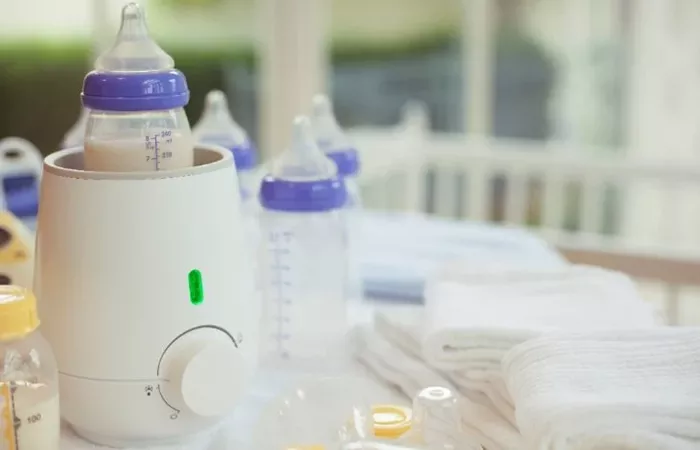A bottle warmer is a device designed to heat a baby’s milk or formula to a safe and comfortable temperature. It is a helpful tool for parents and caregivers, especially when feeding a baby with expressed breast milk or formula. The main goal of a bottle warmer is to warm milk gently and evenly, making feeding easier and safer for the baby. Unlike microwaves or stovetops, bottle warmers reduce the risk of overheating or creating hot spots that can burn a baby’s mouth.
Why Use a Bottle Warmer?
Babies often prefer warm milk because it feels closer to natural body temperature. Warming milk can also help calm a fussy baby and make feeding smoother. However, warming milk incorrectly can destroy important nutrients and antibodies in breast milk or cause burns from hot spots in formula. Bottle warmers provide a controlled way to warm milk safely and evenly.
Types of Bottle Warmers
Electric Bottle Warmers
Electric bottle warmers are the most common type. They plug into a wall socket and use either steam or warm water to heat the bottle. There are two main heating methods:
Warm Water Bath: This method gently circulates warm water around the bottle. It heats milk slowly but evenly, preserving nutrients and antibodies in breast milk.
Steam Heat: This method uses steam to heat the bottle quickly. It is faster but may cause uneven heating and is less gentle on breast milk.
Portable Bottle Warmers
Portable or travel bottle warmers are designed for parents on the go. They can be powered by rechargeable batteries or plugged into a car’s power source. These warmers are compact and convenient for trips or outings, allowing parents to warm bottles anywhere.
Connected Bottle Warmers
Some modern bottle warmers connect to smartphones via Bluetooth. These allow parents to control the warming process remotely, set preferred temperatures, and save settings for future use. This technology adds convenience and flexibility to feeding times.
How Does a Bottle Warmer Work?
A bottle warmer heats the milk by surrounding the bottle with warm water or steam. The heat transfers gently and evenly to the milk inside. This prevents hot spots and overheating. Most bottle warmers have timers or automatic shut-off features to avoid overheating and ensure safety.
Benefits of Using a Bottle Warmer
1. Safe and Even Heating
Bottle warmers heat milk evenly, reducing the risk of hot spots that can burn a baby’s mouth. This is safer than microwaving, which can heat unevenly.
2. Preserves Nutrients and Antibodies
Gentle warming methods, especially warm water baths, help keep the important nutrients and antibodies in breast milk intact. Overheating can destroy these beneficial components.
3. Convenience and Speed
Electric warmers heat bottles faster than traditional methods like placing bottles in warm water baths at room temperature. Portable warmers add convenience when away from home.
4. Easy to Use
Most bottle warmers have simple controls and automatic shut-off features, making them easy and safe to use for busy parents.
Safety Tips When Using a Bottle Warmer
1. Avoid Overheating
Milk should be warmed to about body temperature (around 98.6°F or 37°C). Overheating can destroy nutrients and burn the baby’s mouth. Many bottle warmers have temperature controls to help avoid this.
2. Test the Temperature
Always test the milk temperature before feeding. Shake the bottle gently and place a few drops on the inside of your wrist. The milk should feel warm, not hot.
3. Use BPA-Free Bottles
Choose bottles made from BPA-free plastic or glass. Heating poor-quality plastic can release harmful chemicals into the milk.
4. Clean the Warmer Regularly
Follow the manufacturer’s instructions for cleaning. This prevents bacteria buildup and ensures the warmer works properly.
5. Do Not Use Microwaves
Microwaving baby bottles is not recommended because it heats unevenly and can create dangerous hot spots.
How to Use a Bottle Warmer
Using a bottle warmer is simple:
- Fill the warmer with the recommended amount of water if it uses a water bath.
- Place the bottle in the warmer securely.
- Turn the warmer on and select the desired temperature or time setting.
- Wait until the warmer signals that the milk is ready.
- Remove the bottle carefully and test the temperature before feeding.
When Is a Bottle Warmer Most Useful?
A bottle warmer is especially helpful in these situations:
- Feeding expressed breast milk, which is sensitive to heat and needs gentle warming.
- Feeding formula, which can be warmed evenly and quickly.
- During nighttime feedings when quick and safe warming is needed.
- When traveling or away from home, portable warmers provide convenience.
Are Bottle Warmers Necessary?
Warming milk is not always required. Many babies accept milk at room temperature or even cold. However, some babies prefer warm milk, and warming can help soothe them. Bottle warmers make the warming process safer and easier but are not essential for every family.
Choosing the Right Bottle Warmer
When selecting a bottle warmer, consider:
- Heating method: warm water bath is gentler, steam is faster.
- Portability: do you need a travel-friendly model?
- Ease of cleaning: removable parts are easier to clean.
- Temperature control: adjustable settings help prevent overheating.
- Compatibility: make sure it fits your baby’s bottles.
Conclusion
A bottle warmer is a useful tool for parents who want to warm their baby’s milk safely and conveniently. It helps preserve nutrients in breast milk and prevents dangerous hot spots in formula. While not essential for all families, a bottle warmer can make feeding easier, especially during nighttime or when traveling. Choosing the right bottle warmer depends on your lifestyle, feeding habits, and preferences. Always follow safety tips to ensure your baby’s milk is warmed properly and safely.
Related topics:


